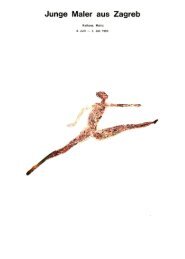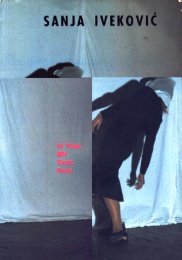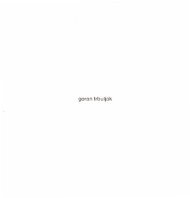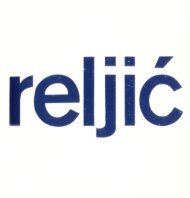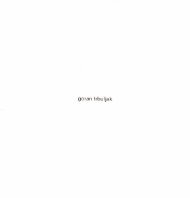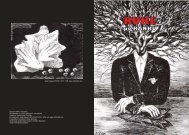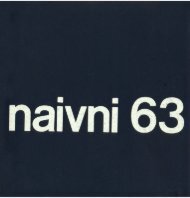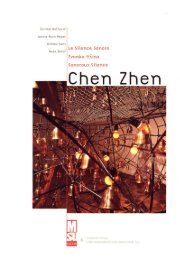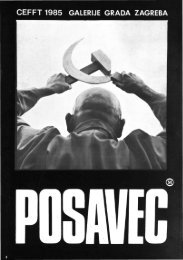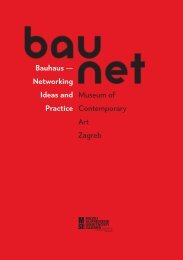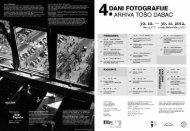The New Art Practice in Yugoslavia, 1966-1978
The New Art Practice in Yugoslavia, 1966-1978
The New Art Practice in Yugoslavia, 1966-1978
- TAGS
- practice
- yugoslavia
- www.msu.hr
Create successful ePaper yourself
Turn your PDF publications into a flip-book with our unique Google optimized e-Paper software.
their first exhibition <strong>in</strong> Novi Sad <strong>in</strong> the autumn of 1970 they<br />
exhibited works which had all the characteristics of pa<strong>in</strong>t<strong>in</strong>gs),<br />
the group KOD were from the start <strong>in</strong>terested <strong>in</strong> language<br />
and the problems it <strong>in</strong>volved, and this was reflected <strong>in</strong> all the<br />
works they produced and <strong>in</strong> all the media they used.<br />
<strong>The</strong> group KOD was founded <strong>in</strong> April 1970. <strong>The</strong> first members<br />
were Branko Andri, Slavko Bogdanovi, Janez Kocijani,<br />
Miroslav Mandi, Slobodan Tima and myself. <strong>The</strong> group was<br />
founded on the <strong>in</strong>itiative of Kocijani. Tima and myself.<br />
We studied literature, wrote poetry, literary and music reviews,<br />
contributed articles for Index and were members of its<br />
editorial staff; we got together regularly for long discussions.<br />
All this resulted <strong>in</strong> the need to undertake a jo<strong>in</strong>t act:on, so<br />
<strong>in</strong> one of the 1969 issues of Index we wrote a project «<strong>The</strong> key<br />
key<strong>in</strong>g the door <strong>in</strong> the door. (we wrote poems and texts on<br />
this topic, varied them and produced several concrete poems<br />
all the work rema<strong>in</strong><strong>in</strong>g <strong>in</strong> the doma<strong>in</strong> of poetry). After discuss<strong>in</strong>g<br />
this with the other future members whom we knew by their<br />
poetry or through discussion at literary even<strong>in</strong>gs, we decided<br />
to set up a group which would carry out <strong>in</strong>vestigations <strong>in</strong>to<br />
new phenomena <strong>in</strong> art.<br />
<strong>The</strong> experience we had at the moment of the found<strong>in</strong>g of the<br />
group ma<strong>in</strong>ly focused on literary poetic work, but there had<br />
been a visible effort (especially by Tima) to transcend the<br />
conventional boundaries of poetry. Earlier dur<strong>in</strong>g our<br />
discussions, and especially at the moment of the found<strong>in</strong>g<br />
of the group, we felt that the efforts made so far <strong>in</strong> this<br />
direction were <strong>in</strong>sufficient, and the need was felt for the<br />
<strong>in</strong>troduction of other media, for an <strong>in</strong>tegral approach to the<br />
problem of art, an attempt to discover new areas which at<br />
that moment were still unknown to us.<br />
In achiev<strong>in</strong>g this, we were to use the variety of <strong>in</strong>terests<br />
and the wide-reng<strong>in</strong>g experience we had so far<br />
acquired: the study of literature with all its problems and<br />
<strong>in</strong>terest <strong>in</strong> phenomenology and structuralism, the problems of<br />
language and l<strong>in</strong>guistics, film and theatre (Miroslav Mandi),<br />
Dada and Surrealism (Slavko Bogdanovi), Wittgenste<strong>in</strong><br />
(Philosophic Investigations and Tractatus). twentieth- century<br />
pa<strong>in</strong>t<strong>in</strong>g, G. Ste<strong>in</strong> (Miroslav Mandi), Fi'mbaud and Mallarme<br />
(especially S. Tima), Borges, McLuhan, Rock and mixed<br />
media (Bora Cosi), pop-art, Duchamp, new music (pop and<br />
electronic), constructivism, OHO, Zen (myself), Nietzsche, later<br />
Freud. then Jung. Euclid's geometry, mythology ...<br />
Found<strong>in</strong>g the group with the <strong>in</strong>tention of do<strong>in</strong>g someth<strong>in</strong>g<br />
new <strong>in</strong> art meant, on the one hand, that writ<strong>in</strong>g poetry or<br />
mak<strong>in</strong>g use of some other conventional form of expression <strong>in</strong><br />
the usual way could not exhaust the possibilities of art<br />
as we saw it, it did not correspond to our nature, to the<br />
nature of our time every artist and every period must<br />
have their proper expression, their own art: the experience of<br />
earlier art or the art of others can serve only as a start<strong>in</strong>g<br />
po<strong>in</strong>t, guidel<strong>in</strong>e, raw-material, but cannot determ<strong>in</strong>e the scope<br />
of activity. On the other hand, by found<strong>in</strong>g the group we did<br />
not adopt a specific model for our activities, thought, life,<br />
mecEa and s<strong>in</strong>ce the latest trends <strong>in</strong> art were <strong>in</strong>sufficienty<br />
known or practically unknown to us, at the beg<strong>in</strong>n<strong>in</strong>g we<br />
ma<strong>in</strong>ly relied on <strong>in</strong>tuition: to realize what we conceived to<br />
be art, with the awwareness that comparisons were possible<br />
and <strong>in</strong>evitable (to repeat an experience which somebody else<br />
has already come upon, to discover later that someone had a<br />
similar experience almost at the same time, or to anticipate<br />
somebody's later experience).<br />
After the found<strong>in</strong>g of the group we agreed that the term<br />
most adequate for our group would be that taken from<br />
l<strong>in</strong>guistics and the <strong>in</strong>formaton theory: we chose KOD (Code)<br />
a system of signs which enables communication, the<br />
transmittance of the message from one system <strong>in</strong>to another.<br />
At first we did not have a clear idea about what we were<br />
to do. We had to come to this through cont<strong>in</strong>ual discussion<br />
and jo<strong>in</strong>t action, which implied regular meet<strong>in</strong>gs, practically<br />
liv<strong>in</strong>g together. We did not feel we belonged to any particular<br />
movement, nor did we set up a movement; that was someth<strong>in</strong>g<br />
to be atta<strong>in</strong>ed through work. In order to present our work and<br />
record it, we decided to set up a review of new art, because<br />
those already <strong>in</strong> existence only partly dealt with the k<strong>in</strong>d of<br />
of art we wished to create. <strong>The</strong> group applied to the Community<br />
of Interest <strong>in</strong> Culture of Novi Sad for funds. It was to be a<br />
quarterly review entitled «KOD» and was to carry works on<br />
the new art by Yugoslav and foreign authors. <strong>The</strong>re was some<br />
disagreement among the members as to whether this review<br />
was necessary at all, but the application was f<strong>in</strong>ally submitted.<br />
<strong>The</strong> funds were not granted.<br />
Some of the ideas, attitudes and reflections set down <strong>in</strong> the<br />
application (April 21, 1970) are <strong>in</strong>dicative of the group's<br />
later work, and they represented the members' views on art<br />
<strong>in</strong> general, on the cultural milieu <strong>in</strong> which they lived and the<br />
way they conceived their own work <strong>in</strong> art. It represented,<br />
therefore, a programme <strong>in</strong> the broadest sense of the term. In<br />
any case, the ideas presented <strong>in</strong> the application could not<br />
have been accepted: the group had known <strong>in</strong> advance that<br />
it would have to rely on its own resources.<br />
«To make a review means to actually live it. Today a review<br />
cannot exist solely by what is <strong>in</strong> it, as this means so little<br />
for fluxus or the concept. For the people edit<strong>in</strong>g the review,<br />
it must be only a way of rem<strong>in</strong>isc<strong>in</strong>g and <strong>in</strong> no case an<br />
opportunity to vent their feel<strong>in</strong>gs: this furthermore means that<br />
the review requires that everyth<strong>in</strong>g that appears <strong>in</strong> the review<br />
should be realized by young people through various systems.<br />
<strong>The</strong> review is thus the reflection of the life of these young<br />
people. <strong>The</strong>refore, a review of this k<strong>in</strong>d is a medium for the<br />
re-exam<strong>in</strong>ation and discovery of different possibilities of<br />
expression with new values. To become a medium for the new<br />
activity, the review must reject the deep-rooted attitude towards<br />
tradition as a heritage or tradition as a monument. It should<br />
proceed from structure, as it is present <strong>in</strong> us ... In order to<br />
exist <strong>in</strong>denpendently, the review has the option not to<br />
appear ... <strong>The</strong> publication should not be more than a record.<br />
It will bear evidence of the time <strong>in</strong> which we live, it will<br />
represent the time and will not simply be its reflection ... <strong>The</strong><br />
publication will cover modern developments <strong>in</strong> all fields of<br />
art. This does not mean that its activity ... will consist only <strong>in</strong><br />
follow<strong>in</strong>g events, it will also try to be creative: the group who<br />
are start<strong>in</strong>g the review and all those expected to contribute<br />
will try as far as possible to discover and <strong>in</strong>troduce new<br />
possibilities for the synthesis of art, assumed by the very<br />
decision to start a publication ... the activity of the publication<br />
would proceed along two ma<strong>in</strong> l<strong>in</strong>es. <strong>The</strong> first is the desire<br />
to follow and gradually become <strong>in</strong>tegrated <strong>in</strong> the latest trends<br />
<strong>in</strong> modern art, thus br<strong>in</strong>g<strong>in</strong>g them closer to a milieu which has<br />
<strong>in</strong>sufficient knowledge of them ... <strong>The</strong> second, even more<br />
important, would cover a) the revival of such trends <strong>in</strong> our<br />
community and b) research <strong>in</strong>to new trends, the use of<br />
experience drawn from them, creativity ... the most important<br />
activity be<strong>in</strong>g the realization of different projects by the<br />
group <strong>in</strong> open space urban space or natural environment..<br />
<strong>The</strong> work which the group planned and started <strong>in</strong>cluded all<br />
the forms of artistic expression. <strong>The</strong> early work falls with :n<br />
the sphere of fluxus and actions, and was most often carried<br />
out <strong>in</strong> the space by the entrance to the Catholic Church (the<br />
so called Catholic Porch) <strong>in</strong> front of the Youth Tribune; it had<br />
the work<strong>in</strong>g title Liberation which determ<strong>in</strong>ed its <strong>in</strong>timate and<br />
anonymous character the spectators were there only by<br />
chance. For <strong>in</strong>stance, <strong>in</strong> the centre of Novi Sad, participant A<br />
(Miroslav Mandi) and participant B (Slobodan Tima) are<br />
stand<strong>in</strong>g back to back. Participant A asks: «What do I see?.<br />
Participant B: «<strong>The</strong> sea. And me?. Participant A replies:<br />
«Antisea.. Or: <strong>in</strong> the centre we all get onto buses go<strong>in</strong>g <strong>in</strong><br />
different directions, we get off after a number of stops, return<br />
and recount our experiences and observations. Or: we walk<br />
around town with Miroslav Mandi all wrapped up <strong>in</strong> white<br />
cre'pe paper.<br />
<strong>The</strong> first public appearance of KOD, when the found<strong>in</strong>g of<br />
the group was first announced, was before the beg<strong>in</strong>n<strong>in</strong>g of an<br />
even<strong>in</strong>g <strong>in</strong> the Parket-salon of the Youth Tribune on April<br />
9, 1970. A spatial <strong>in</strong>tervent:on <strong>in</strong> the Parket-salon (F<strong>in</strong>e <strong>Art</strong>s<br />
Salon) was made: the corners of the gallery were diagonally<br />
l<strong>in</strong>ked by a rope, and then a large number of vertical ropes<br />
were put up with nails hang<strong>in</strong>g from them.<br />
<strong>The</strong> next project, which we recorded (photographed) was<br />
realized on April 18, 1970 accord<strong>in</strong>g to an idea suggested by<br />
Slobodan Tima: <strong>in</strong> the square (the Catholic Porch), between<br />
two build<strong>in</strong>gs, an iron wire construction of a square was<br />
raised to a height of 9 metres by means of a nylon thread.<br />
This meant the plac<strong>in</strong>g of a square, i.e. of someth<strong>in</strong>g that <strong>in</strong><br />
39



